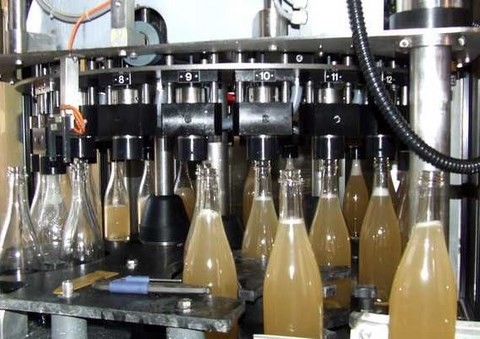THE CUVERIE AND VINIFICATION OF CREMANT

The Cuverie
Our vat room is a building on two levels.
The cellar is semi-buried, which allows to maintain an ideal temperature for our wines.
Every year, we vinify in our cellars about 40,000 bottles.
The cellar is semi-buried, which allows to maintain an ideal temperature for our wines.
Every year, we vinify in our cellars about 40,000 bottles.
Here are some important steps in the vinification of our Burgundy Cremants:

Pressing
After manual picking, the grapes are immediately brought
in the winery and dumped in our Coquard sloped press.
The juice flows slowly and gradually during
3 hours to preserve its quality and clarity.
in the winery and dumped in our Coquard sloped press.
The juice flows slowly and gradually during
3 hours to preserve its quality and clarity.

Fermentation
Juices put in stainless steel tanks will undergo a first alcoholic fermentation.
It allows their transformation into clear wines called "base wines". It will be followed by so-called malolactic fermentation to naturally reduce acidity.
It allows their transformation into clear wines called "base wines". It will be followed by so-called malolactic fermentation to naturally reduce acidity.

The tirage
As with our Champagne neighbors, we practice assembly know-how. This consists in developing crémants with grapes from vines, parcels, or different vintages, in order to reinforce the complexity while guaranteeing a regularity of quality from one year to the next.
Bottling is done in our cellars during the spring.
We then add a draw liquor based on yeasts and natural grape sugar.
The bottles are at this stage blocked with a capsule.
Bottling is done in our cellars during the spring.
We then add a draw liquor based on yeasts and natural grape sugar.
The bottles are at this stage blocked with a capsule.

The aging of wine
Crémant bottles are arranged horizontally, on laths, protected from lights and vibrations. Then, under the influence of yeasts, a second alcoholic fermentation takes place which releases carbon dioxide and creates effervescence. The time of frothing is followed by ripening on the lees.
The duration of the aging on slats of our cremants is, according to the cuvées, from 18 months to 5 years:
this slow ripening on lees, well above the legal minimum duration (12 months according to the decree of the AOC), contributes to the birth of crémants of high quality, fine and harmonious.
The duration of the aging on slats of our cremants is, according to the cuvées, from 18 months to 5 years:
this slow ripening on lees, well above the legal minimum duration (12 months according to the decree of the AOC), contributes to the birth of crémants of high quality, fine and harmonious.

The remuage
A typical step in Burgundy sparkling wines, the bottles are stirred: the goal is to drag the deposit that has formed after the foam to the neck. For this purpose, an automated stirrer is used: the gyropallet.

The dégorgement
The neck of the bottle is soaked in a cold box. The frozen deposit is expelled under the effect of pressure. Before laying the cork and its culverts, a small amount of shipping liquor is added to adjust the dosage (from raw to semi-dry).
The bottles are stored for several weeks in the cellar before being labeled and marketed.
The bottles are stored for several weeks in the cellar before being labeled and marketed.
 English ▼
English ▼ Français
Français